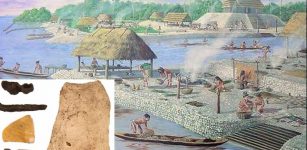World’s Oldest Needles Discovered In Tibet
Conny Waters - AncientPages.com - Archaeologists excavating near Lake Xiada Co in western Tibet have discovered six unusual stone artifacts. These objects measure approximately half the length of a golf tee and feature a pointed tip at one end and an eyelike opening at the other. Upon closer examination, the research team identified these artifacts as ancient sewing needles.
Tibetan lake. Credit: Adobe Stock - Pav-Pro Photography
A study published in the Journal of Archaeological Science: Reports by researchers from Sichuan University claims these sewing needles are 9,000 years old, making them the oldest on record. However, this assertion has been met with some skepticism within the scientific community.
Developing the "eyed" needle represents a significant milestone in human civilization. This innovation allowed our ancestors to create more durable and protective clothing and shelters, enabling them to explore new environments and establish permanent settlements in colder regions.
Historically, the oldest known needles were crafted from bone. Archaeologists have unearthed specimens dating back approximately 50,000 years in Russia's Denisova Cave. Before this recent discovery, the oldest stone needles were only 2,700 years old and were found in China's Henan province.
Radiocarbon dating techniques were applied to analyze charcoal fragments and animal bones discovered alongside the needles. The results indicate that these artifacts date back to a period between 7049 and 6568 B.C.
If confirmed, this new find would push back the origin of stone needles by more than 6,000 years.
The ancient Tibetan artifacts discovered have been subjected to thorough scientific analysis. Researchers have identified the materials used in their construction as tremolite, serpentine, actinolite, and talc. These materials range in color from green to cream, with tremolite exhibiting significantly higher hardness—approximately 70 times harder than talc. Of the artifacts found, only two remained fully intact, while four retained their eye features.
One of the 9,000-year-old needles found in Tibet. Credit: Yun Chen, Sichuan University
To validate the manufacturing process of these needles, the research team conducted replication experiments. They utilized tremolite slabs and obsidian, a hard stone whose microscopic fragments were embedded in Needle 1.
The researchers successfully reproduced the distinctive scraping marks on the needles after approximately 50 minutes of work. Grinding marks characteristic of the original artifacts were achieved by horizontally rubbing the second slab against a rough pebble for about 30 minutes. The eye of the needle was hand-drilled using a pointed obsidian tool, a process that took 5 hours to complete. The resulting hole closely matched those found in the recovered needles.
See also: More Archaeology News
Notably, the entire manufacturing process for these stone needles was at least seven times more time-consuming than creating bone needles, which are softer and more malleable. This significant time investment suggests that the ancient Tibetans had specific motivations for choosing stone over bone as their material of choice.
"Since they were harder and thicker than bone needles, we concluded that these stone needles may have been used to sew thicker materials, such as a tent," team member Yun Chen, a graduate student at Sichuan University, said.
The study was published in the Journal of Archaeological Science: Reports
Written by Conny Waters - AncientPages.com Staff Writer






















